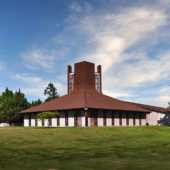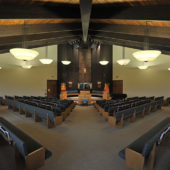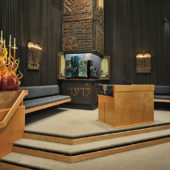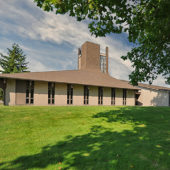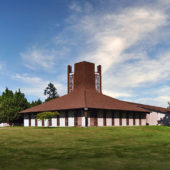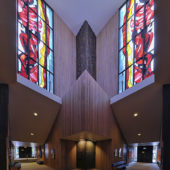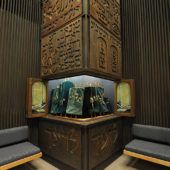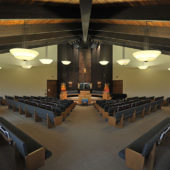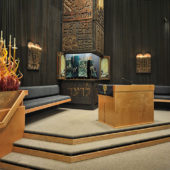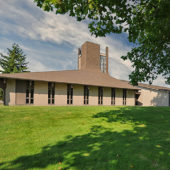The serenity of Beth El’s exterior architecture belies the dramatic interior, each feature having symbolic importance.
In Tacoma, Washington, the Jewish community began celebrating Rosh Hashanah in the 1870s. They would close their stores on Rosh Hashanah and celebrate amongst themselves with a champagne dinner. In 1872 the fledgling Jewish community of nearby Steilacoom, Washington joined with their brethren in Olympia to found a benevolent society and cemetery. In the 1880s, the retail district boomed on Pacific Avenue in downtown Tacoma, inviting a flood of Jewish merchants and their families seeking opportunity.
Despite the unavailability of kosher food and the expectation of a six-day work-week, most of Tacoma’s Jews were able to maintain their Jewish identity. Many timed their buying trips to coincide with Jewish holidays, often purchasing merchandise through a vast network of Jewish suppliers. Most Jewish retailers closed their stores for the High Holy days and Saturdays, leaving the Gentile shoppers of Tacoma to lament the fact that their favorite stores were closed on the Jewish Sabbath. In 1888, a local chapter of B’nai B’rith (the world’s oldest and largest international Jewish service organization founded in 1843) and a Harmony Club (to bring Jews of Seattle and Portland to Tacoma for dances and other social functions) were both founded. The women of Tacoma formed the Lady Judith Montefiore Society (a forerunner of today’s Sisterhood), which operated a religious school for children and provided for needy children.
By 1892 Tacoma’s Jewish community had grown large enough to disagree about doctrine and a split had occurred. An Orthodox Yom Kippur service was held in the Elks’ Hall and a Reform group met in the Unitarian Church. Those who met in the Unitarian Church formally organized themselves as Congregation Beth Israel. In September of 1893, they dedicated Tacoma’s first synagogue building. It continued to be named Beth Israel and was associated with the Reform movement. The Orthodox community became formally organized in December of 1908. Meantime, Tacoma’s Jewish community was moving up from an immigrant neighborhood to an established community in a nicer part of town.
In 1918, Temple Beth Israel sold their building in the old neighborhood and purchased property in the newer, more upscale part of town. A new synagogue was dedicated there in 1922. The Orthodox community followed suit dedicating their new synagogue in 1925. In the thirties, the Orthodox community changed its affiliation to Conservative and re-named itself Sinai Temple. In 1953, Temple Beth Israel hired a dynamic rabbi, Richard Rosenthal. A European immigrant, he eventually became friend to both congregations and in 1960, the two temples merged, at which time the name was changed to Temple Beth El. A new synagogue was constructed to accommodate the additional congregants. The modern building on spacious grounds a few miles southwest of the city center was completed in 1968. Rabbi Rosenthal served until he retired in 1997, continuing as rabbi emeritus until his 1999 death.
One enters Temple Beth El through a long hallway from the parking lot. Along the wall is a timeline, marked with metal pointers beginning with “1967, Jerusalem United.” Next is “18th Century BCE, Abraham comes to Canaan,” bringing the congregant back in time to the roots of Jewish history. The events on the timeline are a reminder of both the diversity and continuity of Jewish history. The sloping, sheltering roof lines of the modern exterior were designed to remind congregants that the first Israelites camped in the wilderness, pitched around the tent of meeting. God’s presence was visualized by a pillar of fire by night and cloud by day. The enormous stained glass windows in the lobby are a modern interpretation of this, symbolizing God’s presence and providential care. The tower between the stained glass windows is inscribed with Hebrew letters, as a reminder of how the Torah brings us to God. In the center of the lobby are two carved panels (this is the back of the Aron Kodesh in the prayer room), which is the Holocaust memorial.
The main prayer room is an impressive room, which like the rest of the building, emphasizes the use of construction materials native to the Northwestern United States.. The Aron Kodesh is a tower comprised of fourteen dark wood panels, telling the story of the development of Judaism etched in Hebrew. The Torah scrolls themselves come from many parts of the world. Their covers, completed in 2000, were hand woven by members of the congregation. Light walls are offset by dark wood paneling. The dark paneled wall behind the Aron Kodesh is decorated with twin tablets inscribed with The Ten Commandments. The tivah (reader’s desk) sits on the platform in front of the Aron Kodesh and is simply carved of light wood. Light woodwork is used on the steps for the bimah and for bases holding candles and stunning artwork amongst the candles appearing to be flames. Benches are simply carved of light wood, with Wedgewood blue upholstery.
In 1993 the temple was renovated, adding over 19,000 of new space for the growing congregation. The rotunda is at the heart of the addition to the building, featuring a metal cover with a Star of David with a circle inside. Underneath this metal cover is a time capsule containing messages from Temple Beth El members to be opened in the future. Just off the social hall is a courtyard with a patio, marked with the names of many of the matriarchs and patriarchs of Jewish history and faith. A sculpture named “Jacob’s Dream,” created by Lucile Hurst, graces the garden.

